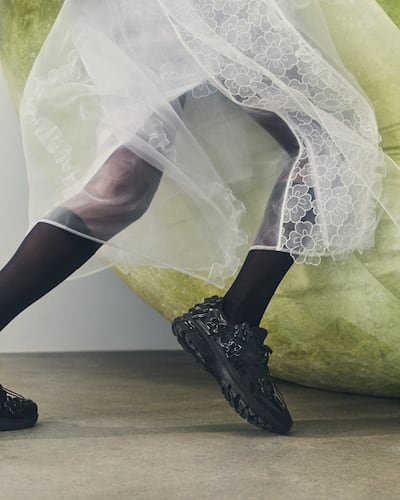When Saucony tapped veteran sneaker executive Bimma Williams last year to reimagine the brand’s 3D Grid Hurricane sneaker, the designer did not hesitate to take creative rein to completely personalise the shoe.
Co-designing with Jon Humphrey of streetwear brand the Beignet Boys, Williams dressed the shoe in his signature purple and adorned the heels with custom-stitched logos — his award-winning podcast, “Claima,” on the left, and a nod to his hometown, Portland, on the right.
“Saucony allowed us to do whatever we wanted on the box, marketing, and design,” Williams explained. “It was great to have that much freedom.”
For activewear giants, collaborations with independent artists and designers like Williams have become standard practice in reaching new niche audiences and generating brand heat. Essentially, most collabs are pretty bland and just an easy marketing tactic — and brands are often incentivised to keep these costs low and avoid risks on new silhouettes that don’t guarantee success.
That’s why the level of creative freedom that Williams received from Saucony is a rarity, according to other indie labels who have worked with the likes of Nike and Adidas. With the exception of high-profile collaborators such as Ronnie Fieg of Kith, who are granted autonomy to introduce new models and ideas, most indie brands receive a common formula from their corporate partners, which rarely deviates from simple colour changes and the addition of a new logo somewhere on the shoe.
According to another British streetwear label that partnered with New Balance earlier this year on one of its heritage models, the Boston-based sneaker giant had a strict formula for the collaboration. “They only give us a few silhouette options based on what they’re focusing on inline that year and there are limitations on the materials we [could] use,” the label’s designer told BoF.
New Balance declined to comment.
“Bigger partners can push boundaries because they have that cultural influence,” said Williams. “For someone like me, the options are more limited.”
The narrow scope of these collaborations is a reflection of a bigger issue in the sneaker industry, insiders say: an overall lack of innovation and over-reliance on hero products, such as Nike’s Air Force 1s and Adidas’ Sambas. These decades-old models are cheaper to produce than new styles and already widely recognised — and coveted — by consumers, creating a “cheat code” for brands to lean on the past without investing much in R&D, said Brendan Dunne, general manager at Complex Networks, the distribution arm at the sneaker culture publication Complex.
But this approach is no longer fool-proof. While the nostalgic appeal of these classic designs is still translating to commercial success — just look at Adidas’ Samba — a growing segment of shoppers are seeking new ideas and silhouettes.
Converse, a former staple in sneaker culture, has seen sharp declines, with revenues down 18 percent year-over-year in its latest quarterly earnings. Similarly Converse’s parent company Nike, is in the same sinking boat. Vans — a brand that built its name on a handful of retro models has seen sales sag in recent years. Though, the skateboarding shoe brand is making a move to combat its shortcomings. By evolving its retro silhouettes with the recent launch of its OTW premium line, offering reimagined versions of its heritage models.
“The retro styles can only go so far; consumers are craving innovation,” said Jessica Ramirez, senior research analyst at Jane Hali & Associates.
Retro sneakers still have a place in the market, especially when their collaborations can push boundaries and reimagine the classics in meaningful ways. The recent success of Salomon and On illustrates that innovative collaborations, even within existing silhouettes, can create excitement among shoppers that results in sales growth.
Sneaker tie-ups don’t have to be boring. In fact, some of the most commercially successful collaborations in recent memory have involved boundary-pushing designs and other creative risks on retro models.
Asics, for instance, teamed up with womenswear designer Cecilie Bahnsen in September of this year, transforming the Asics Gel-Quantum 360 into a Mary Jane-sneaker hybrid. This collaboration went beyond minor adjustments, altering the upper construction of the shoe, adding floral embellishments and swapping laces for straps.

Rather than merely modifying colourways and other minor details, the Bahnsen-Asics partnership showcases a more thoughtful integration of high fashion into sportswear. “People want to stand out,” said Linus Nutland, archivist and designer. “They want something unfamiliar.”
Outdoor brand Salomon’s ongoing line with Maison Margiela’s MM6 label is another example of how a familiar sneaker silhouette can be reconstructed into something entirely new. The Maison Margiela Salomon Cross, for instance, features a slip-on fit and a built-in ripstop gaiter that covers the foot, creating a dynamic, sculptural shape. While unconventional in design, the shoes gained widespread attention when Rihanna wore them during last year’s Super Bowl.
The collaboration helped contribute to Salomon’s popularity. Last year, it was named one of StockX’s fastest-growing sportswear labels, driven by a 202 percent increase in trade activity on the resale platform in 2023.
As more consumers become more selective with their purchases, retailers can help drive demand by focusing on visible newness beyond collaborations, analysts say, giving their customers a new reason to shop.
“Consumers are willing to pay more for performance and quality,” Ramirez said, and quality over quantity is the new norm.
Swiss running sneaker brand On took the lead in this innovation-driven landscape in recent years, gaining recognition for their pioneering cushioning technology called CloudTec.
But what pushes On to the forefront of consumers’ minds is its clever pairing of technology with fashion. Its ongoing collaboration with Loewe saw the creation of trendier versions of the Cloudtilt & Cloudventure models, boosted by Loewe’s recognisable logo.
Performance technology alone won’t cut it. A crucial reason why footwear brands such as On have been able to stand out is their emphasis on comfort too.
“My main focus is just comfort,” said Nutland. “After owning a pair of Ons and Hokas, I understand what true footwear comfort is.”
As the sneaker industry grows increasingly competitive, even giants like Nike and Adidas must push beyond their comfort zones to capture consumer interest.
“We’re going to go into a pocket of hyper experimentation,” said Williams. “We’re going to see a lot of small trends popping up, because we want to feel like we’re connected to something real that doesn’t feel superficial.”
In this environment, brands will have to fight harder than ever to stand out — or risk being left behind.




